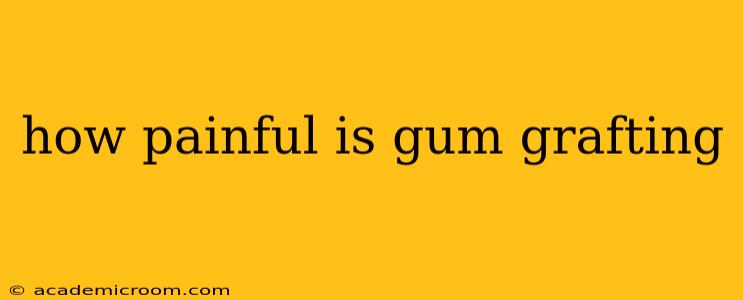Gum grafting, a procedure to restore gum tissue lost due to gum recession or periodontal disease, is a common oral surgery. Many patients wonder about the pain involved. The truth is, the experience varies significantly from person to person, and several factors influence the level of discomfort. This guide will delve into the specifics, addressing common questions and concerns.
What is Gum Grafting?
Before discussing pain levels, let's understand the procedure itself. Gum grafting involves taking tissue from another area of the mouth (often the palate) or using a synthetic graft to cover exposed tooth roots. This protects the roots from sensitivity, decay, and further recession. There are various types of gum grafts, each with its own nuances, but the core principle remains the same: restoring gum tissue.
How Painful is Gum Grafting During the Procedure?
Most patients receive local anesthesia during the procedure, rendering the area numb. This significantly reduces or eliminates pain during the grafting itself. You might feel some pressure or tugging, but sharp pain should be minimal to nonexistent.
What is the Pain Like After Gum Grafting?
Post-operative pain is a different story and is the main concern for many patients. The level of discomfort varies greatly depending on several factors, including:
- Individual Pain Tolerance: Some individuals naturally have a higher pain tolerance than others.
- Type of Graft: Different grafting techniques might lead to varying levels of post-operative discomfort.
- Extent of the Procedure: Larger grafting procedures naturally involve more recovery time and potential discomfort.
- Post-operative Care: Following the surgeon's instructions carefully is crucial in minimizing pain and promoting healing.
Generally, patients report mild to moderate pain in the days following the procedure. This pain is often described as throbbing, aching, or soreness. Over-the-counter pain relievers like ibuprofen or acetaminophen are usually sufficient to manage this discomfort. In some cases, your surgeon might prescribe stronger pain medication.
How Long Does the Pain Last After Gum Grafting?
Most of the significant pain subsides within the first few days. However, some mild discomfort or soreness might persist for a week or two as the gum tissue heals. The healing process is gradual, and you should expect a progressive decrease in pain over time.
Will I Need Pain Medication After Gum Grafting?
Most patients find over-the-counter pain relievers adequate for managing post-operative pain. Your surgeon will likely provide recommendations on pain management, including the type and dosage of medication appropriate for your case. In cases of severe or persistent pain, contact your dentist or periodontist immediately.
What Can I Do to Reduce Pain After Gum Grafting?
Several steps can be taken to minimize discomfort following the procedure:
- Follow Post-Operative Instructions Carefully: This includes medication schedules, rinsing instructions, and dietary restrictions.
- Apply Ice Packs: Applying ice packs to the affected area can help reduce swelling and pain.
- Eat Soft Foods: Avoid hard, crunchy, or acidic foods that could irritate the healing gums.
- Rest: Give your body adequate time to rest and recover.
Are There Any Long-Term Pain Issues After Gum Grafting?
Long-term pain after gum grafting is uncommon. Most patients experience complete healing and minimal to no lasting discomfort. However, if you experience persistent pain or other complications, it is crucial to contact your dentist or periodontist.
Is Gum Grafting Worth It Despite the Potential Pain?
Despite the potential for some temporary discomfort, the benefits of gum grafting often outweigh the pain. The procedure can significantly improve oral health, preventing further gum recession, tooth loss, and sensitivity. A healthy gum line contributes to a more aesthetically pleasing smile and better overall oral health. The temporary discomfort is a small price to pay for long-term oral health benefits.
This information is for general knowledge and does not constitute medical advice. Always consult with a qualified dentist or periodontist to discuss your specific concerns and determine the best course of action for your individual circumstances.
